As the public comment period proceeds for Governor Brown’s twin tunnels plan, last month state legislators took a closer look at the controversial project in a pair of oversight hearings held in the state capitol.
The twin tunnels plan, officially known as the Bay Delta Conservation Plan or BDCP, is the administration’s plan to fix the ailing Sacramento-San Joaquin Delta and recover its threatened and endangered species by building new water conveyance facilities in the north Delta to convey the water to the existing facilities in the south Delta as well as restoring substantial amounts of habitats in and around the Delta. Proponents of the plan say the new plumbing is needed to correct the problems with reverse flows and fish entrainment in the Delta, and that combined with extensive habitat restoration, the plan will contribute to the recovery of native species. Opponents of the plan say it will only deplete the fragile estuary of needed freshwater flows, turning it into an inland salty sea and hastening its demise.
The first of two separate hearings was led by Delta area Assemblyman Jim Frazier, who heads the Assembly Committee on Accountability and Administrative Review, and it focused on how the plan would be paid for, and included testimony by Department of Water Resources Laura King Moon, Legislative Analyst Anton Csorba-Favorini, and Central Valley Flood Protection Board’s Melinda Terry.
Later that month, the Senate Natural Resources and Water Committee and the Assembly Committee on Water, Parks, and Wildlife held a joint informational oversight hearing on the Bay Delta Conservation Plan where Secretary of Natural Resources John Laird, flanked by Department of Water Resources Director Mark Cowin and Department of Fish and Wildlife Director Chuck Bonham made their case for the project. Afterwards, a panel of stakeholders were given the opportunity to give their perspective.
Oversight Hearing: The Funding Structure and Economic Impacts of the Bay Delta Conservation Plan
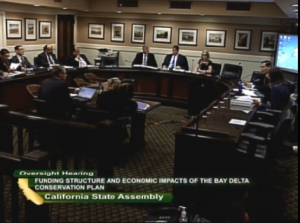 On February 12th, the Assembly Committee on Accountability and Administrative Review led by Delta area representative Jim Frazier held an oversight hearing to look at the funding details of the Bay Delta Conservation Plan, as well as the economic impacts to the region.
On February 12th, the Assembly Committee on Accountability and Administrative Review led by Delta area representative Jim Frazier held an oversight hearing to look at the funding details of the Bay Delta Conservation Plan, as well as the economic impacts to the region.
The hearing led off with Department of Water Resources Deputy Director Laura King Moon explaining that the BDCP’s construction will be financed through the sale of revenue bonds. Current contract provisions could used to bill SWP contractors for debt service for construction, but more likely a contract amendment will be agreed upon with provisions to cover the costs, including debt service, she said.
The $25 billion plan relies on the state and federal water contractors to pay for the new water conveyance facilities and their operations and maintenance as well as the mitigation. The ecosystem restoration portion, accounting for roughly 30%, would be paid for by state and federal funding sources.
It is appropriate to rely on these state and federal funding sources as other ambitious restoration projects around the nation have been funded similarly, said King Moon. “The Delta is an ecosystem of national significance,” she said. “Public funding for programs of this nature is consistent with other large scale restoration efforts that involve large ecosystems of national significance, such as the Lower Colorado River, Platte River, Chesapeake Bay, Great Lakes, and the Florida Everglades.” In the event of a shortfall in state or federal funding, the BDCP’s resources could be readjusted, the contractors could voluntarily make up the shortfall, or even reduce the scope of the plan and its regulatory assurances in proportion to the funding shortfall, she said.
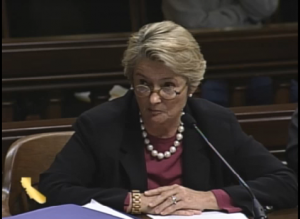 Assemblymember Olsen expressed her concerns that although the plan states it won’t affect long-held water rights, she doesn’t understand how that would work. “We have salt intrusion and other sorts of problems partly because we don’t have enough water in there, and now we’re going to convey more water out of the Delta without storing more water above the Delta to be able to convey and so how, in practicality, are we not going to be touching pre-1914 water rights?” she asked King Moon.
Assemblymember Olsen expressed her concerns that although the plan states it won’t affect long-held water rights, she doesn’t understand how that would work. “We have salt intrusion and other sorts of problems partly because we don’t have enough water in there, and now we’re going to convey more water out of the Delta without storing more water above the Delta to be able to convey and so how, in practicality, are we not going to be touching pre-1914 water rights?” she asked King Moon.
“We’re not conveying more water out of the Delta with this facility; we’re conveying it more reliably,” responded King Moon. “It’s up to the State Water Board to protect all the pre-1914 water rights and they will continue to do that.”
The project is not increasing capacity, King Moon emphasized. “We can’t move any more than is in the canals, and we won’t be able to increase that capacity by having the new diversion point. Reality is that we’ll be taking more water at the northern diversion points, and much, much less water at the southern diversion points. The total will be roughly the same,” explained Ms. King Moon.
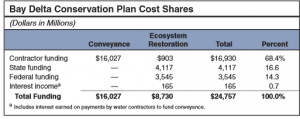 LAO Analyst Anton Csorba-Favorini testified that the cost assumptions used for the BDCP’s cost estimates were generally reasonable, and the contingencies are relatively in line with engineering practices from what he can tell, although he noted that some cost assumptions could be improved. However, he said that it’s unclear whether the benefits of the tunnels will outweigh the costs in the long run. “There are two factors that could affect the net benefits,” he said. “The first one is the question of cost overruns; if the costs end up being higher, the net benefits are lower. The second one is that the benefits of the BDCP are predicated on essentially what the value of the water coming out of BDCP would be. If there’s lower demand for water, that would reduce the benefits to some degree. Similarly, if there are lower costs for alternatives to BDCP like water recycling or desalination, that might lower the relative benefits of BDCP.”
LAO Analyst Anton Csorba-Favorini testified that the cost assumptions used for the BDCP’s cost estimates were generally reasonable, and the contingencies are relatively in line with engineering practices from what he can tell, although he noted that some cost assumptions could be improved. However, he said that it’s unclear whether the benefits of the tunnels will outweigh the costs in the long run. “There are two factors that could affect the net benefits,” he said. “The first one is the question of cost overruns; if the costs end up being higher, the net benefits are lower. The second one is that the benefits of the BDCP are predicated on essentially what the value of the water coming out of BDCP would be. If there’s lower demand for water, that would reduce the benefits to some degree. Similarly, if there are lower costs for alternatives to BDCP like water recycling or desalination, that might lower the relative benefits of BDCP.”
Economist Jeff Michael told the Committee that the costs of the BDCP are absurd for an irrigation project. “The majority of the water exported from the Delta is for agriculture,” he said. “I don’t see how investing in BDCP would be a profitable investment for farmers unless their cost share goes way down. … My estimate is that the cost share would have to go down to 10 to 20% before it would even start to make sense for agriculture.”
San Diego’s Dennis Cushman told the Committee that after the 1991 drought which hit the region hard, the Water Authority has since worked hard reduced its reliance on Metropolitan Water by making investments in regional self-reliance. The Water Authority efforts have been successful, cutting their reliance on Metropolitan water by half since 1991 with plans for further reductions. He pointed out that LA DWP is working to reduce it’s purchases of Met water, and other Metropolitan member agencies are following suit.
Cushman said this could have implications on Metropolitan’s ability to pay for the project. “Metropolitan has pledged to pay 25% or more of the BDCP project costs, but Metropolitan relies on water sales for 85% of all of it revenues,” Mr. Cushman pointed out. “Yet Metropolitan’s member agencies are not obligated to buy any water from Metropolitan – there are no long term commitments to buy any water in the future, so we think that’s an issue of concern since Metropolitan will be the financial foundation of the BDCP by providing the largest potential share of funding for BDCP.”
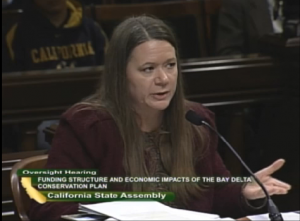 There are flood liability considerations as well warned Melinda Terry, Executive Director of the Central Valley Flood Protection Association. She pointed out that the BDCP could potentially expose the state to liabilities as determined by the Paterno decision, a court ruling that determined the state was liable for a 1986 levee failure, a decision that eventually cost the state over $400 million to settle. “The BDCP proposes to make the largest modification to this state flood system that has ever been done since it was built,” she said. This may mean extra exposure to both the state and the Central Valley Flood Protection Board who already has the responsibility, but potentially the CVP and the SWP itself, she said.
There are flood liability considerations as well warned Melinda Terry, Executive Director of the Central Valley Flood Protection Association. She pointed out that the BDCP could potentially expose the state to liabilities as determined by the Paterno decision, a court ruling that determined the state was liable for a 1986 levee failure, a decision that eventually cost the state over $400 million to settle. “The BDCP proposes to make the largest modification to this state flood system that has ever been done since it was built,” she said. This may mean extra exposure to both the state and the Central Valley Flood Protection Board who already has the responsibility, but potentially the CVP and the SWP itself, she said.
She also expressed concerns that the BDCP documents do not analyze flood flows, a key issue for the region. “It wasn’t analyzed at all,” Terry said. “Construction of the facilities proposes to have ten cofferdams in the Sacramento River and other channels at the same time. It’s a 9 year construction period. I’ve looked back 110 years. The thing I can guarantee you based on the historical record is we have one major flood event every decade.”
“Furthermore, they did not factor that in whatsoever or analyze that they are modifying a state facility for which another entity has responsibility for,” Terry continued. “They didn’t analyze any of the flood flow capacities or how it changes any of our eligibility – none of it. They didn’t’ even recognize that the state owns and is responsible for it.”
Joint Oversight Hearing: Bay Delta Conservation Plan Update
The controversial project had a little bit easier time of it at the second hearing when on February 25, 2014, the Senate Natural Resources and Water Committee and the Assembly Committee on Water, Parks, and Wildlife held a joint informational oversight hearing on the Bay Delta Conservation Plan. Administration officials briefed the legislators on the latest information, and then a panel of stakeholders were given the opportunity to give their perspective.
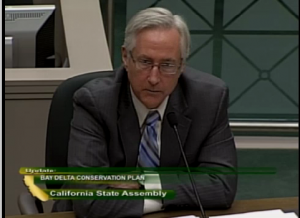 The Bay Delta Conservation Plan is not the singular answer to the problems we face, but rather a vital component of the broader strategy as outlined in the California Water Action Plan released by the administration last month, Department of Water Resources Director Cowin told the legislators. “Providing a reliable, sustainable Delta water supply has to go hand in hand with all the other actions that are described in that water action plan, including better storage capability, improved groundwater management, and more efficient use of water through conservation, recycling, stormwater management, and other types of projects and approaches,” Cowin said. “It’s going to take steady progress and investment in projects, large and small, across the state in order to safeguard our water resources for the future.”
The Bay Delta Conservation Plan is not the singular answer to the problems we face, but rather a vital component of the broader strategy as outlined in the California Water Action Plan released by the administration last month, Department of Water Resources Director Cowin told the legislators. “Providing a reliable, sustainable Delta water supply has to go hand in hand with all the other actions that are described in that water action plan, including better storage capability, improved groundwater management, and more efficient use of water through conservation, recycling, stormwater management, and other types of projects and approaches,” Cowin said. “It’s going to take steady progress and investment in projects, large and small, across the state in order to safeguard our water resources for the future.”
The administration recently extended the deadline for the comment period by another two months, closing in June. “Our goal is to make sure that as many people as possible provide comments, all of which will be carefully considered,” said Secretary of Natural Resources John Laird, adding that the extension is not expected to create any significant delays.
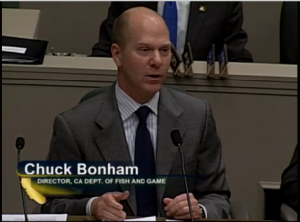 Department of Fish and Wildlife Director Chuck Bonham testified that the documents currently out for review have some significant improvements, such as more clarification on the roles of the agencies, the biological goals and objectives, compliance and permitting relationships, and the adaptive management process, as well as an improved dispute resolution process.
Department of Fish and Wildlife Director Chuck Bonham testified that the documents currently out for review have some significant improvements, such as more clarification on the roles of the agencies, the biological goals and objectives, compliance and permitting relationships, and the adaptive management process, as well as an improved dispute resolution process.
Bonham also acknowledged there was more work to be done. “There is more conversation is ahead on the appropriate match between the commitments in the plan to biological outcomes, the biological certainty or not around those commitments and the commensurate regulatory assurances,” he said. “Those need to be in equilibrium, and there’s more conversation ahead to be had there.”
However, he cautioned not to get too caught up in the details. “I think that it’s incredibly important that the content of the Bay Delta Conservation Plan be good, but it may be the case in the long run that implementation will be even more challenging and more important to get right, because the implementation term arguably will last longer than this year or two where we’ll discussing the particular details of the plan content. … That might be a more important place for us to focus now at least as important as some of the specific biological content.”
Delta counties still struggle to find their role in the massive plan, an issue Laird said he is handling personally. “We are committed for a role of the Delta counties in governance and to have them formally have a seat at the table in regard to any project,” he said. “We are dealing with individual impacts and issues that they have as best we can, making sure they lay it on the table and we are trying to address them.”
After administration officials were through testifying, Delta stakeholders had a chance to give their perspective. Metropolitan Water District’s Steve Arakawa said the BDCP is needed because the system in the Delta today is not capable of reliably capturing ample supplies. “We have a lot of challenges,” Arakawa said. “We need to manage around the fisheries and we need to manage around the weather, and that’s going to be important and how to get to a BDCP that provides for supporting the coequal goals of restoring the Delta ecosystem and improving water supply reliability. “
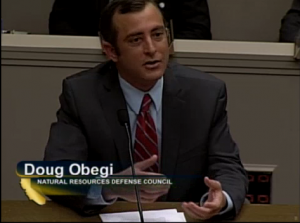 Northern California concerns remain despite assurances, Northern California Water Association’s David Guy told the Committee. “With respect to BDCP, we’re still watching flows and fees,” Guy said. “It still feels to us that there’s an expectation that there’s going to be flows from Northern California required to support the project, and whether it’s through the BDCP, the State Water Board, or some related process, that fear is very much in Northern California’s mind.”
Northern California concerns remain despite assurances, Northern California Water Association’s David Guy told the Committee. “With respect to BDCP, we’re still watching flows and fees,” Guy said. “It still feels to us that there’s an expectation that there’s going to be flows from Northern California required to support the project, and whether it’s through the BDCP, the State Water Board, or some related process, that fear is very much in Northern California’s mind.”
Doug Obegi from the Natural Resources Defense Council said his organization still had many concerns. “In terms of the ecosystem benefits, we are very concerned,” Obegi said. “Right now, the modeling in BDCP shows that salmon populations generally decline; some of them go potentially extinct, and more importantly, survival through the Delta is actually reduced as a result of BDCP. So this is not just climate change … We cannot do nothing to affect our reservoirs and let salmon go extinct because salmon support thousands of jobs in communities across Northern California and Oregon.”
Cost concerns remain as well, both in terms of overruns and who will pay, Obegi said. “We think there’s a real concern that urban Southern California and Santa Clara Valley will be asked to subsidize the agricultural contractors who get about two-thirds of their water from the Delta through these two water projects.”
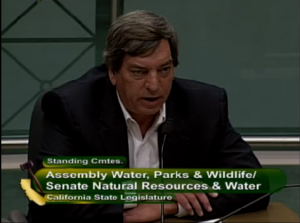 Westland Water District’s Jason Pelteir said he wasn’t sure the state and federal fish agencies can make decisions in the face of uncertainty. “We hear repeatedly from the federal fish agencies that there is so much uncertainty about what would happen if we created new habitat and created new diversion points that they don’t know if they can permit this, so they are going to be deciding our future, there’s no doubt about it. And I don’t know that they can decide. I just don’t know if they have it in them to make the decision given the uncertainty.”
Westland Water District’s Jason Pelteir said he wasn’t sure the state and federal fish agencies can make decisions in the face of uncertainty. “We hear repeatedly from the federal fish agencies that there is so much uncertainty about what would happen if we created new habitat and created new diversion points that they don’t know if they can permit this, so they are going to be deciding our future, there’s no doubt about it. And I don’t know that they can decide. I just don’t know if they have it in them to make the decision given the uncertainty.”
“The second challenge is the landing a project that works,” continued Mr. Peltier. “We don’t have a project that works today from our perspective. We don’t have a project that has adequate water supply and that has costs that we can afford or assurances that we can go into the future knowing we have a reliable water supply, so we have a lot of work to do, as the Director and the Secretary said, to get to a point where we have a project that actually works, not just for the exporters, but to address the continued declines of fisheries in the systems and the local issues in and around the Delta.”
Written by Chris “Maven” Austin
You must be logged in to post a comment.